Tyler KD8CPP of West Virginia sent us this note:
In Wood County West Virginia, we have a group, which I am a proud member of, called wood county emergency communications. I thought I would give a few, but outdated (we do have it updated though), pictures of our vehicle. See below and attached.
Communications:
1 – low band radio: 32 channels (36 – 50 mhz) public safety & business band.
2 – high band radios: 99 channels (150 – 170 mhz) public safety & business band.
1 – uhf band radio: 160 channels (450 – 470 mhz) public safety & business band
4 – two meter voice radios: 130 channels (144 – 148 mhz) amateur radio
1 – two meter packet radio: 14 channels (144 – 148 mhz) amateur radio
1 – hf radio: (3.5 – 30 mhz am/fm/cw/ ssb) amateur radio
1 – marine band radio ( all channels)
20 – uhf walkie-talkies: 14 channels (462 – 467 mhz) family radio service
16 – uhf walkie-talkies: 6 channels (450 – 470 mhz) public safety gmrs
1 – 12 volt portable uhf repeater: (input 467.550 mhz output 462.550 mhz)
1 – cellular telephone: phone number (304) 481-0611
3 – programmable scanners: (30 – 470 mhz) used as auxiliary receivers
4 – digital packet radio stations: used for secure communications
3 – laptop computers: for use with packet radio stations
1 – tone alerting encoder: for toning out fire departments & ambulance
1 – gps receiver: location system
2 – portable packet radio nodes: for use with digital communications
4 – two meter voice radios: 130 channels (144 – 148 mhz) amateur radio
1 – two meter packet radio: 14 channels (144 – 148 mhz) amateur radio
1 – hf radio: (3.5 – 30 mhz am/fm/cw/ ssb) amateur radio
1 – marine band radio ( all channels)
20 – uhf walkie-talkies: 14 channels (462 – 467 mhz) family radio service
16 – uhf walkie-talkies: 6 channels (450 – 470 mhz) public safety gmrs
1 – 12 volt portable uhf repeater: (input 467.550 mhz output 462.550 mhz)
1 – cellular telephone: phone number (304) 481-0611
3 – programmable scanners: (30 – 470 mhz) used as auxiliary receivers
4 – digital packet radio stations: used for secure communications
3 – laptop computers: for use with packet radio stations
1 – tone alerting encoder: for toning out fire departments & ambulance
1 – gps receiver: location system
2 – portable packet radio nodes: for use with digital communicationsAntenna equipment:
11 – 7 foot antenna mast pipes
4 – wire antennas for hf stations
2 – ringo ranger – 2 antennas tuned for two meters and public safety
5 – magnet mount roof top antennas
Coax cables (various lengths)
Rope (various sizes and lengths)Electrical:
Generator: 1000 watt honda & 5 gallons gasoline and 1 gasoline siphon hose
Extension cords: 3 – 50 foot 10/3 cords
2 – uninterrupted power supplies (permanent mounted)
2 – uninterrupted power supplies (portable) Ups outputs are 120 volts 250 watts
2 – 5 amp power supplies
2 – 300 watt 12 volt dc to 115 volt ac inverters
18 – 12 volt 25 amp hour batteries: (main power source) good for a minimum of 12 hours of operating time, each with quick disconnect plugs.Miscellaneous:
IBM 486 computer with monitor, printer and zip drive
2 – green “command post” strobe lights (mounted on top of vehicle)
2 – pair Bushnell 12 x 50 binoculars
2 – 25 watt/115 db siren bullhorns
2 – 500,000 candlepower hand held spotlights
3 – flashlights with orange wands
12 – status boards and easels
1 – 10 x 10 canopy and 1 – 10 x 20 canopy (both self supporting)
10 – clipboards, miscellaneous secretarial supplies
I’m not exactly sure why he sent us these photos….. I mean, does he even read this site????!
in any case, visit the Wood Country Emergency whatevers at: http://www.wc8ec.com/
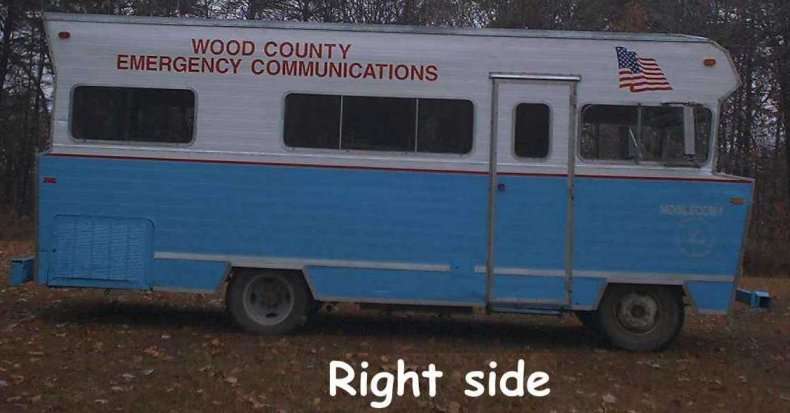
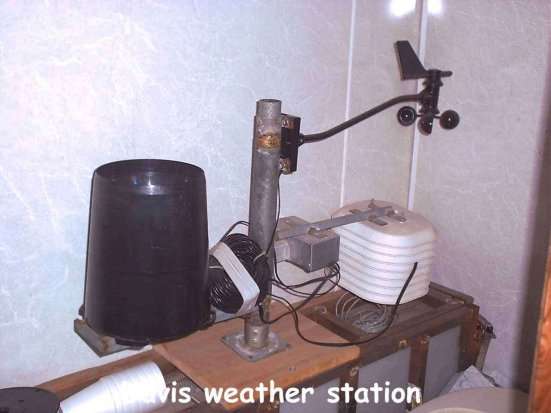
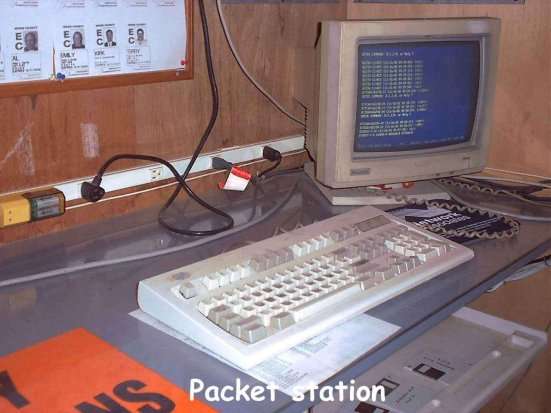
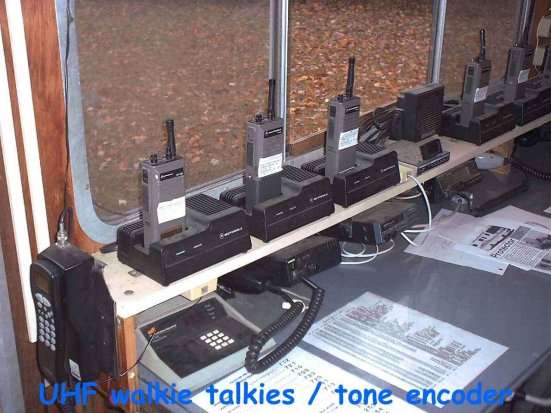
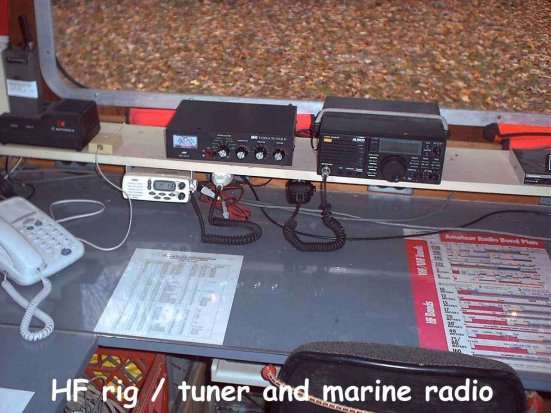
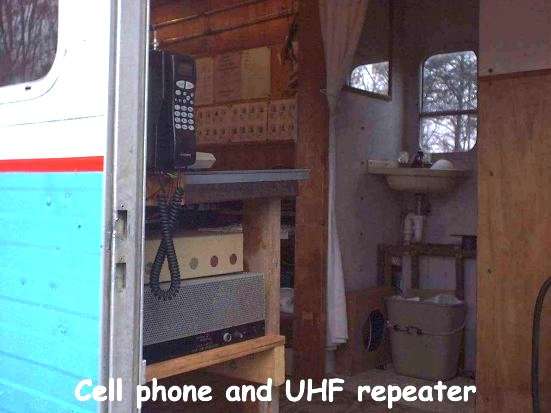
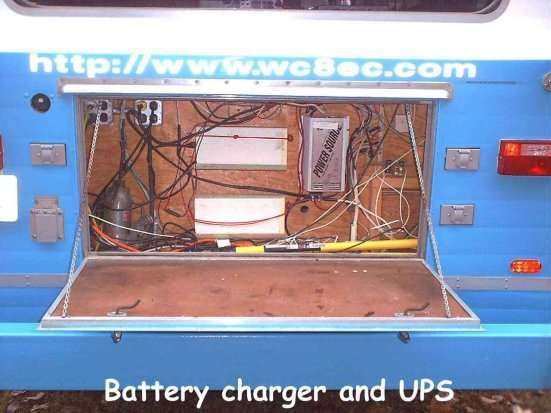
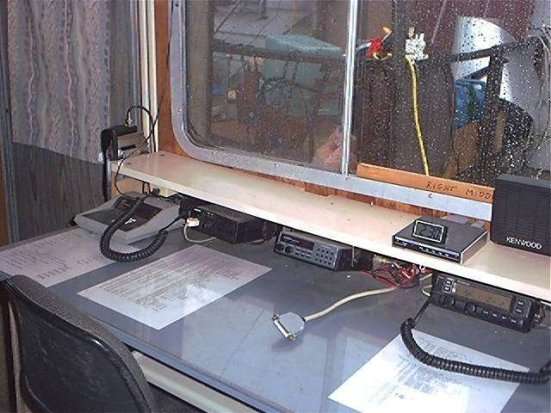
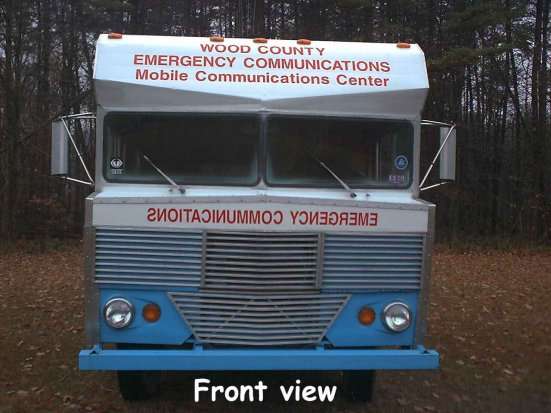
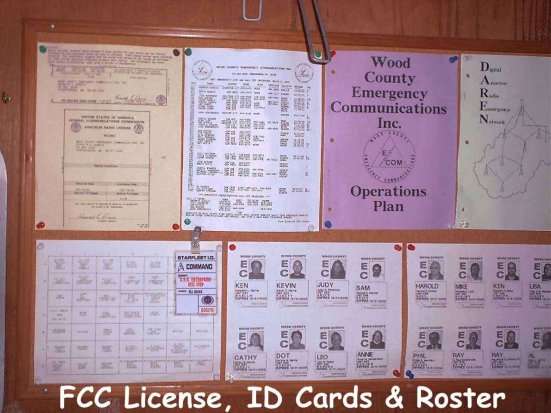
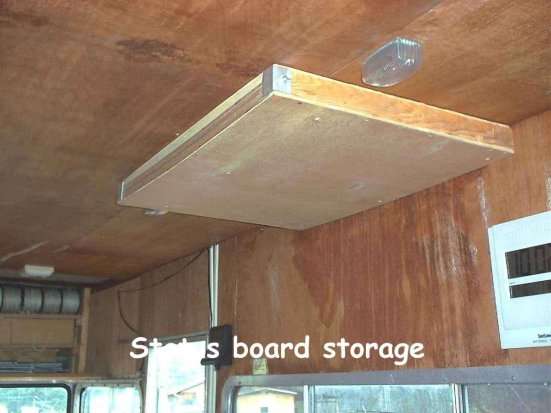
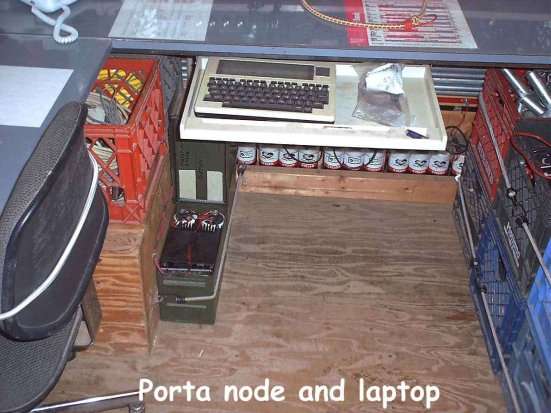
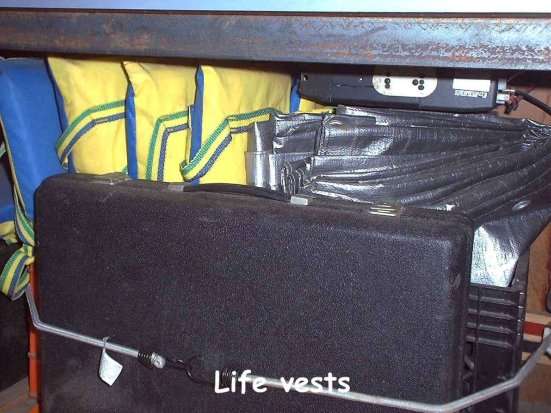

Looks like a time capsule from 1989.
you are right! that begs to be updated!
First, that computer is a real 1989 gem.
The generator will burn out in 15 minutes. You need an Onan Marquis 7000. It is the most quiet 7K gas genset out there and is designed for RV use. You will need more then 5 gallons of gas, but your motor home should have a 75 gallon tank anyway.
Everything should run off 12 volts, lights, radio, computer network, EVERYTHING except the air conditioners. Next, a bank of Trojan T105 6V batteries in a series parallel config for the 12v source, and the engine should have a separate power source so that if you run the comm shack batteries down, you can still start the engine and escape. You also need a bridging switch so you can start the engine if the engine battery is dead, or start the genset if the comm shack batteries are dead.
VE3HBD: I do read the site, I thought it would make a good addition.
K8YS: it is updated, equipment wise, but who the hell needs an airconditioner? We have a gene, and that will recharge the batteries, and the bago. The coms are isolated from the starter battery, and the gene is hand start. The computer does what it needs, which is packet.
Ok… So…
We have an ID badge that shows “Starfleet Command”
A marine radio and life vests. WHY? Its West Virgina!
“You in the lake, STAND UP! Thats right stand up and walk towards me!”
The RV can handle 1200+ pounds of battery?? (18 x ~68 Pounds). I would be checking the frame and axle for damage.
I think it’s neat-o, when can we go campin’?
eh
that’s modern for wv
Wow, all those radios that operate in the MILLIHERTZ range. I KNEW my old WWII lowfer gear would communicate with someone else stuck in the dark ages!
Oh, just read through your power sources…in CERT agencies, the PERSONAL “must have” deployment kit is for 144 hours…any kind of comm van is supposed to be self-sufficient for 14 days. That 1kW generator ain’t enough to charge many of those batteries all at once, if you’re in full-bore operation with as many radios as you can have on the air at once, can you go 14 days 24X7?
Also seems like you don’t have enough antennas to support all the radios. In my (fairly frequenty) emergency deployments, I have discovered that bad WX tends to trash the antennas faster than the radios, so we always have MORE antennas than radios, not the other way ’round.
THe 1000w gene is just for basic lighting/etc. we have a larger one that goes down in a como truck.
any other questions? We have it handled!
Ok… So…
We have an ID badge that shows “Starfleet Command”
A marine radio and life vests. WHY? Its West Virgina!
“You in the lake, STAND UP! Thats right stand up and walk towards me!”
The Starfleet Command is a joke,
The marine radio os because the ohio river is at our door steps several times a year, and the Port of Mid Ohio Valley Coast Guard is here, The life vests are for members if the ohio is at our door. look at all the deaths from floods in places like Central Texas and plces like that.
How do you deal with shelf-life issues? Are the batteries AGM’s ? Do you use STA-BIL in your generator’s gasoline?
The batteries are Gell-Cells, I think that is AGM, I have never reffered to them that way, and the gasoline is replaced every few months, because it ends up getting used at one of our events, such as safety fairs, bingo, or the free coffie things at rest aeras.
AGM and gell cells are 2 different things. AGM is really what you want, but they cost more. Read about ’em on Google. They have far better shelf-life.
If you really wanna spend a few bucks, get set up with a solar panel and a charge regulator. That way your batteries will always be topped off and ready to go.
Consider buying STA-BIL at walmart or a car parts store. It increases the shelf-life of gasoline which might be a good idea if you’re storing gas for more than 1-2 months.
Everytime I see the first photo I am reminded of “National Lampoon’s Chistmas Vacation” and the cousin’s RV.
“it is updated, equipment wise, but who the hell needs an air conditioner?”
Ever been in a car in the summertime? I’d bet the Winnebago is an oven. And let’s not forget…all those radios in there give off heat–as well as the people.
Try this: put 5 operators in there for 4 hours running the equipment in the middle of August (call it a “thunderstorm scenario”) and batten down the hatches (to keep the “storm” out). Then you’ll know what I’m talking about.
It gets hot, humid and smelly in there real fast….kinda like a hamfest…
Rabidjade:
Merry Christmas!! Shitter was full!!
How about a CO detector or two? Portable genset or propane powered heater makes this a must have item.
Dr WHo would be proud of the accomplishment.
“Lets do the time warp again.”
Dr. Who would be proud of the accomplishment.
“Lets do the time warp again.”
Alright, The list is non extensive. We have done a “thunderstorm Scenario” it sucks, but waht did people do in the old days?
You’re right – don’t use any A/C. It’s important to remember this vehicle’s purpose is emergency/disaster communications. A/C would use more power than the rest of the rig put together, and is a luxury item completely uncalled for. Yes, when a disaster goes on for a long time, people stink. You’re trying to save lives, not win points from babes at a cocktail party.
A/C wasn’t common in the southern U.S. until the mid-1970s. People knew the simply joy of a 5 min cool shower or running through a sprinkler and summer was fine, indoors or out. Let’s not allow our spoiled-ness get away with too much!
My continued concerns are these:
1) Vehicle is not self-sufficient. It requires a generator from a second vehicle (whatever a “como van” is). Very, very bad design to depend on two vehicles – one could break down, and then where are you? Both of them would be grounded.
2) Only one HF rig, no backup
3) Not enough antennas to support the radios.
I would reduce the radio count (except add a backup HF rig) so that there’s room in THIS van for the generator that’s required to keep it going. Use the second vehicle (“como van”) to hold the radios removed from this vehicle, so that now you have two self-sufficient comm vehicles, each with fewer radios than this one example. You should definitely not create a vehicle that requires the presence of a second vehicle in order to do its job for a long time. Rethink the antennas for both vehicles, make sure you have backups for when the wind blows down your first one…that’s for all bands, do not forget HF.
Also agree on the AGM (absorbed glass mat) batteries. I don’t trust gel cells for more than a few years at the most, it is surprising how quickly they can just quit. I had some four year old gel cells measure at 95% of charge capacity (by drawing rated current from them and identifying when the v-drop got to spec), then two weeks later, 10% of charge capacity. Also, if you try to fast-charge a gel cell, you can create an air bubble in the gel that never heals – this leads to permanent loss of charge capacity. Sealed wet cells are actually a better choice, if you ever plan to charge them faster than C/10. Batteries are close to your most important concern. Look for AGMs, then consider sealed lead-acid (SLA), not gel cells.
Good luck.
What a travesty.
Merry Christmas…Shitters full…cousin Eddie….Christmas Vacation.
Sorry, someone already posted christmas vacation quotes. I would like to see one of these com vans with a souped up engine with nitrous and a super charger.
We have updated the vehicle!!!! We do have 2 HFs, and our director has about 15 that he has in the back of his truck. The gene goes in the bottom storage, and it CAN, i checked, run the vehicle, angin those are the OLD specs, we have a 5000w gene that goes with us now.
The antenna count does NOT include all the NMO 3db antennas on the top of the bago.
We had a similar, but not quite so outfitted, motor-home with AC. The on board generator was sufficient to handle everything, but was loud. When we ran the AC connected to shore power if the plug / outlet / adaptor combo was not over sized we would get melted plugs and / or adaptors.
Radios don’t draw all that much current.
We had a bigger problem with intermod when we tried to use several 2 meter frequencies at the same time. This was cured by using cross band repeaters and going out on 440 and listening on 2 meters.
I have also noticed that when the comm vehicle is also used as a command post there is far too many distractions and noise for the operators. We have successfully experimented with moving the command post to a different location than the comm post. The operators loved the set up. Command had radio access to the comm vehicles which had radio access to everywhere. It worked great and there were far less repeats needed.
The ideal setup would be to also have a trailer set up for command and kept separate from the comm shack.
CPP, you are a brave soul for posting here and kudos to you for responding to the questions here and keeping the thread almost civil.
Thanks for the compliment, I try my best!